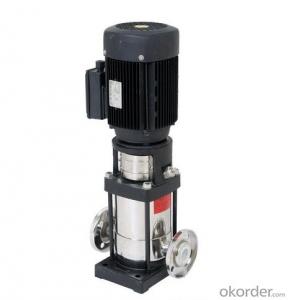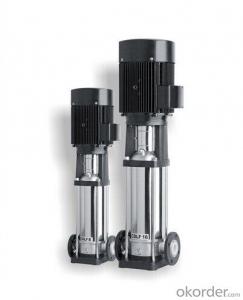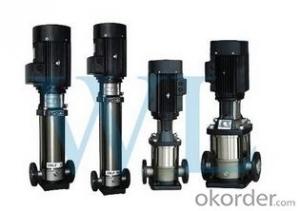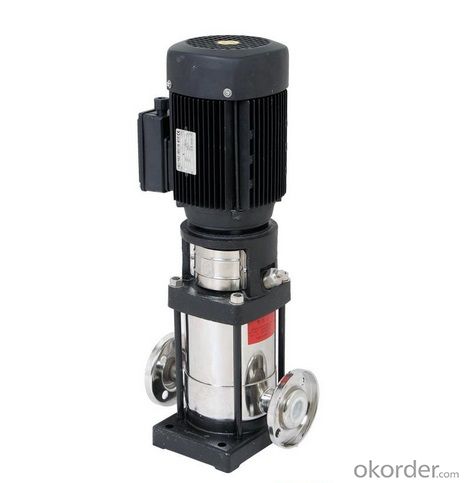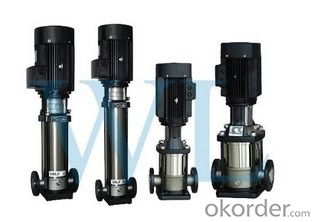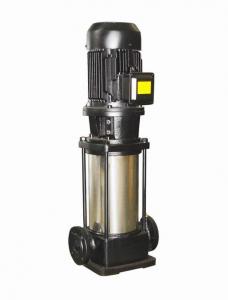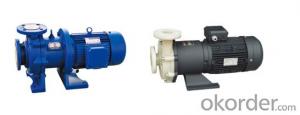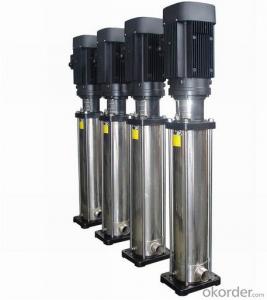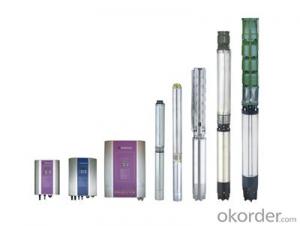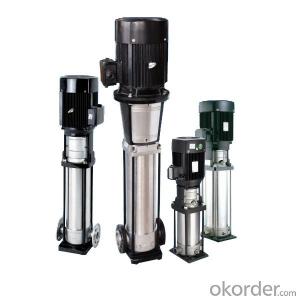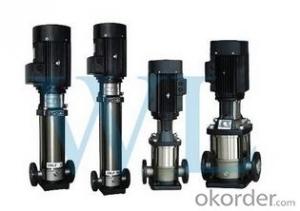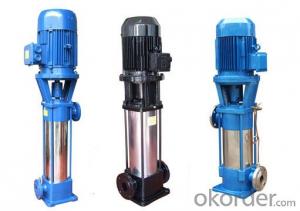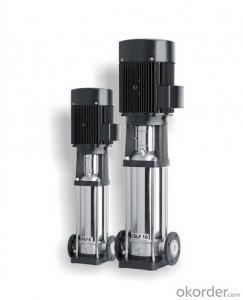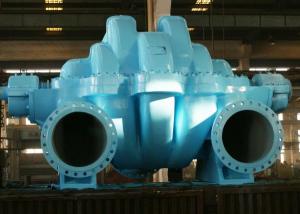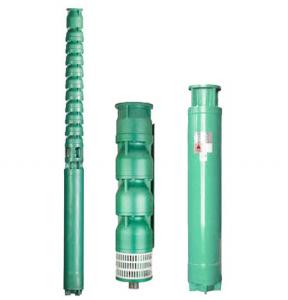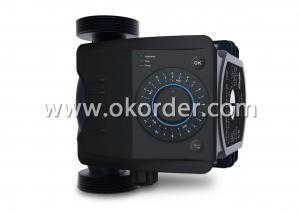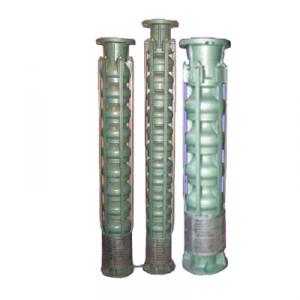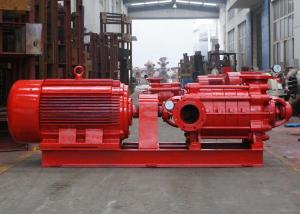CDL Stainless Steel Vertical Multistage Centrifugal Water Pump
- Loading Port:
- Shanghai
- Payment Terms:
- TT or LC
- Min Order Qty:
- 1 unit
- Supply Capability:
- 3000 unit/month
OKorder Service Pledge
OKorder Financial Service
You Might Also Like
1. Performance of CDL Series Stainless Steel Vertical Multistage Pump
Flow Range:1-200m3/h
Head Range:11-200m
Power Range:0.37-110KW
Temperature:-20ºC-120ºC
Material:Stainless Steel 304,316
Work Pressure:<1.6mpa< span="">
2. Introduction of CDL Series Stainless Steel Vertical Multistage Pump
Non self-priming type vertical multistage centrifugal pump, the motor is directly connected with the pump through shaft couplings, impeller guide vane is made of stamping stainless steel plate or precision casting stainless steel, smooth surface , hydraulic flow loss is small, and easily for cleaning, is very favorable for conveying pure medium. Pump inlet and outlet in a straight line(can be equipped with IEC or NEMA motor).
3. Operating Conditions of CDL Series Stainless Steel Vertical Multistage Pump
Thin, clean, non inflammable and explosive liquid not containing solids or fiber.
The liquid temperature: normal temperature type - 15 ºC to 70 ºC hot water type to + 120 ºC
Environmental temperature: highest + 40 ºC
Height: highest 1000m
4. Motor Introduction of CDL Series Stainless Steel Vertical Multistage Pump
Motor is fully enclosed, air-cooled type 2 pole standard motors.
Protection grade: IP55
Insulation grade: F
Standard voltage: 1Ph 220-230/240V
3Ph 200-220/346-380V
3Ph 220-240/380-415V
3Ph 380-415V
5. Typical Applications of CDL Series Stainless Steel Vertical Multistage Pump
Water supply: water filtration and conveying, waterworks water supply, pipe pressurization, high-rise building pressurization.
Industrial pressurization: process water system, cleaning system, high pressure flushing system, fire control system.
Industrial liquid transportation: cooling and air conditioning system, the boiler feed water and condensation system, machine tool accessory, acid and alkali.
Water treatment: ultrafiltration system, reverse osmosis system, distillation system, separator.
Irrigation: farm irrigation, sprinkler, drip.
6. FAQ
1> Can I get trained on CNBM products?
Yes, we provide training courses in our factory (products, general and specific pump technology, hydraulics, and practical applications). Please consult your sales manager or get in touch with our headquarters for more information.
2> Are your pumps cheaper than those of your competitors?
CNBM aims to give its customers the highest standards of quality and service and delivery times, all at a reasonable price.
3> How long is your warranty?
Unless otherwise expressly authorized in writing, by specifying a longer period or different conditions, CNBM states that, for a period of twelve (12) months from delivery date, all Products supplied are free from defects in materials and workmanship, and conform to the applicable specifications. Either the delivery documentation or the invoice must be provided to prove delivery date. In absence of such documents, the production date appearing on the product label may suffice.
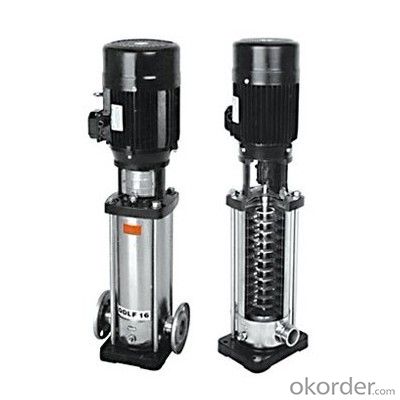
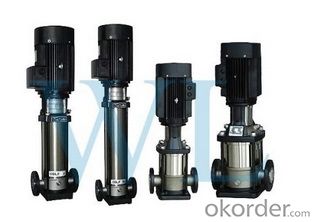
- Q: Pump suction and pressure side road why should vacuum table and pressure gauge, and what role they have?
- The pump suction and pressure side roads shall be equipped with a vacuum meter and a pressure gauge to monitor the operation of the system. When the pump is running, if the suction side of the vacuum decreases, indicating that the performance of water pump or water absorption pipe leakage; if the vacuum increases, it may be blocked suction pipe. The pressure on the water side is too large. It may be less water or the water pipe is blocked. If the pressure drops, the water consumption may increase or the water pump performance will decrease.The pressure gauges on the water side also play an important role in observing the pressure changes at the start of the pump to determine when to open the outlet valve. Usually larger pump starts, should first close the outlet valve to reduce the starting current, until the pressure of the pump rising and stable, then open the outlet valve.
- Q: I received a call from my daughter who said that the water pump was making a grinding noise. She sent a photo to me showing 0 psi on the gauge. I came home to find it actually working again but after running water straight from the pump I found that it is really rusty. What is this caused from? Our water was nice and clear! We've had freezing conditions here. Still doesn't explain the sudden rust.
- Ok there are several possibilities one is that since pressure went to zero you stirred up sediment in the surge tank especially if it is the old style before bladder type also if air got into pipes that will loosen rust but these are minor and will clear with time and use but i would worry what is wrong with pump that goes to zero and makes noise you better check that out or your at risk it wont restart next time
- Q: A guy i know changed the Water pump on my 02 Chrysler Sebring with a 2.7 in it because it was leaking coolant, when i got it back the leak was fixed but now there is a ticking noise. He thinks that the Timing Chain Tensioner needs to be replaced... can i get some opinions here? does he sound correct?
- It is possible. The water pump is driven off the timing chain on that engine. Why didn't he replace the tensioner when it was apart is a good question. The fact that it is now ticking isn't a good sign. I hope it was lined up properly.. get it looked at soon before there is the potential for damage.
- Q: A 0.13hp electric motor on a water well pumps water from 30.23m below the surface. The density of water is 1.0 kg/liter. How many kg of water does the motor pump in 2.20hr?
- It is known that 1 hp = 746 watts, so 0.13 hp = 97 watts = 97 Joules/s The amount of work to lift 1 kg water a vertical distance = 30.23 m = mgh mgh = (1)(9.81)(30.23) = 296.6 J no. of seconds in 2.20 hr = (2.2)(3600) = 7920 s total work output of a 0.13 hp pump in 2.2 hr if 100% efficient = (7920)(97) = 768,240 J no of kg lifted by 100% efficient pump/motor in 2.2 hr = 768,240/296.6 = 2590 kg ANS
- Q: I need to fit a booster pump to increase pressure from a gravity fed vented solar water heater (uses vacuum tubes).The problem is that the temperature of the water from the solar panel can be very high - in fact it could boil under some circumstances. It's safe because the system is vented.As the quot;solarwater feeds existing water heaters in the house, diluting the hot with some cold prior to the pump with an automatic mixer valve is not really an attractive option as we want to gather as much hot water as possible.Can anyone tell me where to get a booster pump that can operate at up to 100 Deg C, delivering 2 bar pressure and about 25 liters per minute. Thanks.
- Yes you can as per the other answer . Make sure when you do you dont exceed the Gallons per minute of the cellar pump or you will burn up the pump on your house . Also make sure that the pump in your moms house can only pump up to 50 psi . Most well pumps can pump higher but that is the setting on the presure switch You might be able to change the tank and switch in moms cellar to a bigger presure tank and up the presure on the presure switch and cure the problem that way and not work the well pump so hard by turning off and on so often .
- Q: I have a small stream by my backyard where my garden is and I want to use that water so I will need a pump with a hose attachment. What kind of water pump will I need to get for this?
- You okorder /
- Q: where would I be able to find information on how to change out a water pump for that specific type of vehicle and year, as well I had got a stain on the body from road work it seems to be cement how could I take spots out without damaging the body's paint? What are my options thanks...
- this is not that big a deal, this engine is 3/4 ths of a chevy sbc 305, which is basically the same as small block chevys from 1955 forward-the good thing is that this can be done quite easily in the car, just remember this engine has a serp belt, so take note of where the belts go and how the pulleys are aligned with all the accessories. DO NOT break the seal on the a/c unit, just take off the compressor and set it to the side, same with the power steering and alt. Once you get through the pulley system, just remove 4 bolts on the front of the pump, remove it, you have already drained the coolant, and keep it, either reuse it or dispose of properly, remove the pump, and clean off the old gaskets from the front of the engine block. Take the old pump with you, get one that is the exact same as the one you took off-do not allow the old pump to be taken by the parts store, buy an all new unit, not a rebuilt, and keep your old one until the new one is installed and functions properly-I know, I am probably overly protective, but many times I have brought home what appeared to be the correct pump, and it did not work, then I did not have my old one to look at to see exactly what i needed...good luck, as far as the paint, well, use a solvent to soften whatever is stuck to the paint, if it in fact is concrete, not cement as that is the powder that concrete is made from, then try a little vinegar, it is slightly acidic, will dissolve the concrete, and the spot can be removed gently, hopefully without chipping the pain-here is the good news, concrete does not chemically bond with paint, so you should have no problem...good luck, be careful.
- Q: how to replace water pump in a 96 F150?
- 1. drain coolant 2. remove engine fan and clutch assembly 3. remove radiator hose connection at water pump 4. remove water pump 5. clean water pump to engine mating surfaces 6. install water pump with water pump gasket 7. rest of installationin reverse order of removal
- Q: should replace timing belt & water pump on a newly purchased used vehicle..if no records of last x changed?
- It is wise to seek advise from professional mechanics as to what process you are considering to do with this vehicle. This vehicle is 2013-1994= 19/20 years old presumably in service since 1994. The miles you report as under 160,000 miles. You inquire as if you are inexperienced in automotive affairs. Well, here is my experience speaking. Any vehicle over 100,000 miles is to be suspect of wear and tear and even abuse by prior owners and they require inspection and evaluation. Engines are to be checked for compression and leaks, electrical system, corrosion, engine mounts, exhaust, transmission, coolant system, etc. etc. etc. Only a trained mechanic can do this. Unless you have receipts, records at a dealership, etc. as evidence of service and repairs, then all parts are original. You ask as to the timing chain. I expand to include everything proposing short of an engine rebuild. Cars do a lot of work and suffer deterioration each second the motor runs and each inch the car moves over the earth. IF there an inspection plate or port that provides for a viewing of the condition of the timing belt, a mechanic will know. My car, a 2001 Audi TT has that feature. Now, imagine the purchase price of this Toyota, add the expense of the inspection and possible repairs such as the timing belt, water pump, thermostat, radiator cap and coolant replacement, possible a new radiator, suspension parts, exhaust parts, etc. in need of replacement, etc. and it is up to you to decide IF this vehicle is worth the expense for no matter how money you spend, the retail market value shall remain the same. That means around $2,500 to $2,700. This vehicle, as new, was not and is not now, a fuel efficient vehicle with an average MPG of 14 MPG on a good day. I do not know as to your driving needs but at 60 MPH and 14 MPG that mean each 14 miles $3.50, average, goes out the tail pipe for a nice $14.00 per HOUR cost on fuel. Kind of expensive. You choice and decision. Good luck.
- Q: I have a well that is 6inch and down 250 ft. It use to be used to water our grove. The submersible pump went bad and I had it pulled and capped. I was wondering since the water level in the pipe is around 6 feet down, can I install an above ground jet pump to feed my house? Could I just go down around 30 feet and pump with the above ground jet pump instead of using the submersible pump? tks for any help..
- yep hook up a shallow well pump with a head of around 30 feet
Send your message to us
CDL Stainless Steel Vertical Multistage Centrifugal Water Pump
- Loading Port:
- Shanghai
- Payment Terms:
- TT or LC
- Min Order Qty:
- 1 unit
- Supply Capability:
- 3000 unit/month
OKorder Service Pledge
OKorder Financial Service
Similar products
Hot products
Hot Searches
Related keywords
